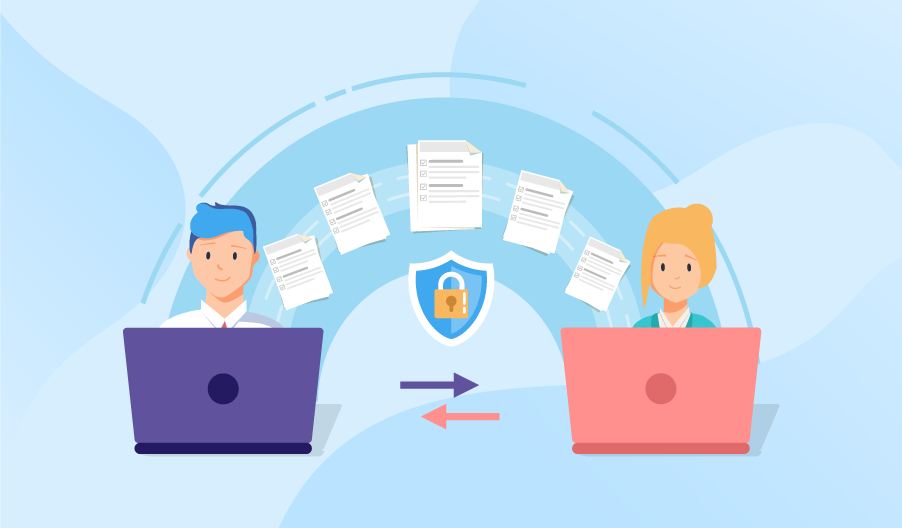Best Practices of Online Document Collaboration
Real-time team collaboration tools help employees avoid miscommunications, accelerate decision-making, enhance creativity and productivity. Among the most popular online collaboration software are standalone tools like Google Docs, Zoho Docs, Box, Dropbox and full-fledged platforms like Office 365 by Microsoft. Office 365 offers diverse document collaboration options with online versions of Word, Excel, PowerPoint, OneNote and other tools. Also, it includes SharePoint that provides robust online collaboration on documents. However, together with the advantages, online document collaboration brings about some serious challenges. For example, an ability for multiple users to edit each document can make the editing process endless.
In this article, we’ve accumulated the best practices of collaboration on documents that can be supported by document management tools.

1# Document collaboration management
Effective team collaboration on documents is controlled collaboration. Control can be practiced through the following measures:
Clear separation of roles
Each member of a collaborative team should be able to freely edit a document only if the team has the same roles, for example, when a team of sales reps is making a draft of a contract. But if a team consists of members with different roles, this should be reflected in relevant permissions as, for example, a sales rep, a lawyer and an accountant look at a contract’s draft from different perspectives. In such a case, role-based permissions can be as follows:
- Owner (viewing and editing documents, giving and revoking permissions, lock editing).
- Collaborator (viewing and editing documents).
- Reader (only viewing documents).
- Commentator (viewing and leaving comments to documents).
Separation of drafting and editing
A collaborative team should have the total context prior to editing a document. So, editing should start only after a final draft is ready. And an early draft of a document should be accessible for viewing only.
Defining timeframes
Clear timeframes should be set for each stage of document drafting or editing. For example, an early draft of a document should be ready by the end of the day and a final draft – by the end of the week.
Assigning only one document owner
To make document collaboration effective, its management should be centralized and rest with only one owner. A document owner should be responsible for final checking and settling conflicts as regards disputable changes in a document, setting timeframes for co-authoring stages and locking down a document or its parts for editing.
Restricting the number of co-authors
To avoid chaos and lengthy co-authoring, it’s important to invite only relevant people to online collaboration on documents. And if a document is bulky or has separate sections related to different departments or teams, it’s better to divide ownership between them. Thus, they can focus on their own section and won’t interfere with the work of other teams.
2# Communication
Best practices related to arranging effective communication during online document collaboration include:
Instant messaging
Using messengers helps team members quickly get answers to their questions that come up during working on a document and settle disputable issues. Thus, they save time and avoid multiple reworking afterwards. Also, many online collaboration tools allow saving live chat messages right alongside a document and enable search by conversations, which helps team members not to ask the same questions over and over again.
Commenting
During editing a document, collaborators should leverage commenting instead of overwriting text or changes made by other team members or delete some parts of the document. They can leave comments on specific sections and tag other team members to notify them about their feedback. Team members can also use approval notifications during real-time collaboration on documents: if they agree with a document section, their initials will automatically appear on the page after they approve a section.
3# Document consistency and security
To maintain security and consistency of documents, we recommend the following best practices:
Tracking versions
Using the versioning capability of real-time collaboration tools helps identify what changes have been made to a document, when and by whom. This feature allows immediately detecting unauthorized access and modification of sensitive documents.
Preventing document leaks
Many real-time collaboration tools have the capability to restrict saving documents to desktops, mobile and portable devices. It’s especially relevant for remote workers who work on sensitive documents from their personal or borrowed computers. These tools can also prevent copying and printing out documents, which guarantees that sensitive documents will stay exclusively within the collaboration area and won’t be left in plain view accidentally.
Controlling access to documents
Document collaborators should monitor access to documents in work and react to changes in a timely manner. For example, external access to a document should be revoked as soon as a user no longer needs it. To avoid errors, it should be done automatically by setting a specified period after which access will expire.
How to collaborate effectively
Following the best practices and supporting them with the use of relevant tools will make effective online collaboration happen. Turn to ScienceSoft’s consultants to help you establish technology-powered collaboration in your company or put it on the right track.

